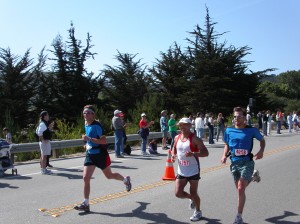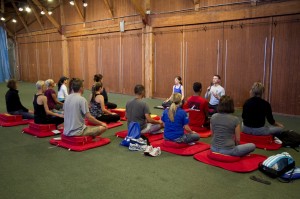Thursday
Featured StoriesCan Meditation Help Your Running?
 Interview with Amy Conway by Michelle Hamilton, of Runner’s World
Interview with Amy Conway by Michelle Hamilton, of Runner’s World
photo by Martina Brehmer
Article originally found here
Silence fell over the room as the meditation instructor asked the group to lower their eyes. Shoulders dropped. Breath deepened. It’s what you’d expect from a meditation session — except for the thump and buzz of music and conversation on the other side of the curtain. There, thousands of runners picked up bib numbers and browsed the booths of the San Francisco Marathon expo.
Combining running and meditation is not new, but the race was the first to fold the practice into its pre-race seminar line-up. This year’s sessions followed the publication of the book Running with the Mind of Meditation: Lessons for Training the Body and the Mind by Sakyong Mipham, the leader of Shambhala, a meditation approach and philosophy rooted in Buddhism. Shambhala teacher Amy Conway, who led both sessions, shares what she sees as the benefits for runners.
Why meditate prior to a race?
Amy Conway: Meditation can help a runner focus on his or her goals. Over time, the benefits are greater. Like the body, the mind gets stronger and stronger with consistency. But everyone’s awareness is being cultivated. We’re contacting an inner strength, connecting to our inherent confidence. In this way, the mind becomes and ally and a tool in our running.
How? Can you give an example?
AC: When we connect to that deeper, stronger part of ourselves, it gives us confidence that if we hit the wall at 16 or 20, we know we have the ability to work through it.
People think meditation is spiritual or lofty but it’s just training your mind. We train it to overcome obstacles. If you find yourself disappointed in your progress, or if you have an injury and need patience, or if like Sakyong Mipham, you get a blister in a race, you have to decide what to do. Do you stop or walk or talk yourself through it? There’s no right answer, you have to decide, but meditation builds that inner strength.
The book is Running with the Mind of Meditation. How do you meditate when running? And if you’re doing that, why also do sitting meditation?AC: There are various techniques in the book about how to meditate while running, but the best way to start is to follow the breath. Using breath as the object of meditation — what you bring your awareness back to — is easy to start with because when you’re running the breath is easy to find. If you get distracted by a bus or something, notice that, and come back to the feeling of the breath.
Sitting meditation is still important because the body and mind need stillness and movement, like training and rest. It’s yin and yang. We are a very active rush-rush culture, and sitting meditation balances this. In addition to that, training the mind in stillness is easier and allows more strength to develop so that when we are in a more chaotic situation, the mind is ready and strong.
How has meditation changed your own running?
AC: I ran the San Francisco Marathon in 1998 before I was a meditator and Big Sur in 2004 after being a meditator for five years. For the first one, my goal was logging miles and I relied on music to get through my run. In 2004, I was more interested in the experience of running, the feeling of it, even if it was painful or hard, because I was less afraid of that pain. I knew I could handle it. My form improved because I was paying attention to it and I didn’t get injured like I had the first time because I was more in tune with my body.
What questions did runners ask at the sessions?
AC: One runner in Friday’s sessions asked if this will make me faster. There are no guarantees but others have experienced this. One Shambhala instructor, John Pratt, ran a very fast time, which was not his intention, but he won his age category. It’s possible that meditation can help make you faster because you’re not getting in your own way.
Another questions was, “Am I supposed to stop thinking?” You’re definitely not trying to stop thinking. The distractions and thoughts are a natural part of the technique. If we didn’t have that we would not have a training ground. In Shambhala meditation, the outside world is included. Some other practices focus on shutting out the senses, but we include distractions, all sounds and sights. [The practice is done with the eyes open.] In this way, we can apply meditation to everyday life. You’re teaching the mind that there can be stillness, mindfulness in the midst of chaos. So notice the thought, then go back to your object of meditation.
To continue reading, please visit: news.runnersworld.com
Bay Area-based writer Michelle Hamilton is a Runner’s World contributing editor.

















